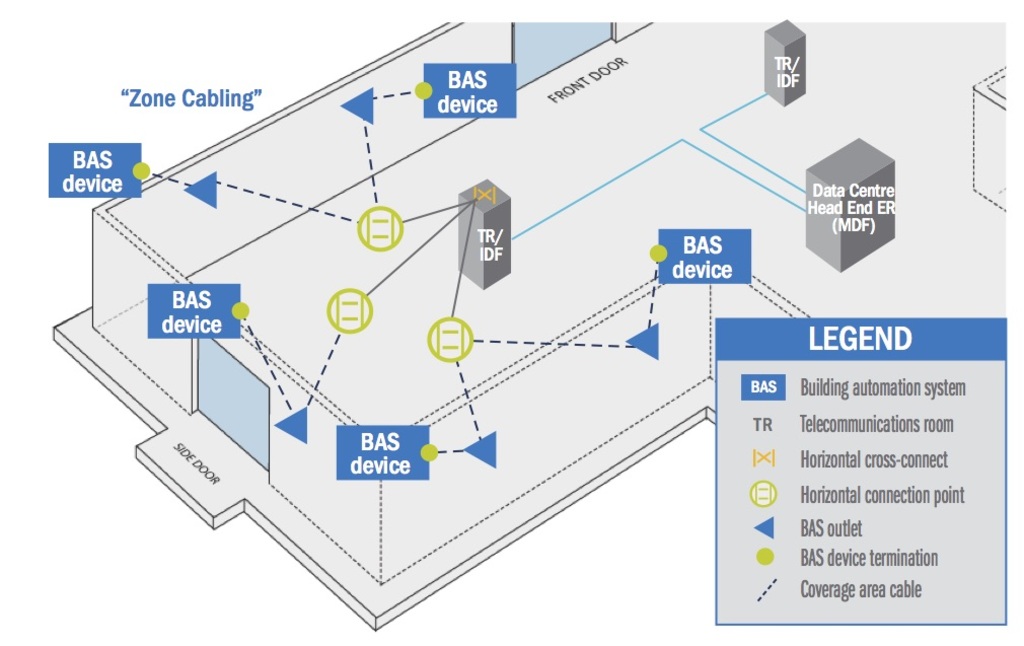
Brian Sims
Editor

Brian Sims
Editor
The smart building is no longer a vision of the future; it’s here and in high demand. The surge in construction of smart buildings, also known as connected or intelligent buildings, has been driven by the desire for safer, more efficient environments that enable occupants to optimise their productivity.
“Remarkable advancements have been made in artificial intelligence and content analytics that will transform how video surveillance and access control solutions are deployed in smart building and smart city application environments,” said Andy Jimenez, vice president of technology at Anixter, a leading global distributor of security solutions and end-to-end smart building infrastructure. Jimenez is among Anixter’s cadre of technical experts who serve on standards committees for organisations such as BICSI, TIA, IEEE and ONVIF.
According to Jimenez, smart buildings are made possible by the structured cabling that provides the foundation for the communication of information across a wide range of network-enabled devices. The implementation of these devices—and their future growth—requires a flexible, high-performance structured cabling system.
Expanding on this theme, the ANSI/BICSI 007-2017 Intelligent Building standard provides best practice guidelines for the design and implementation of structured cabling systems within intelligent buildings. The standard additionally provides cabling design recommendations for building automation systems, low-voltage lighting, combined data and power transmission—such as Power-over-Ethernet (PoE)—and the various other systems that comprise an intelligent building.
Integrators can read ANSI/BICSI 007 for insight on how to meet communications infrastructure demands, ensure flexibility for growth and changes in technology, and integrate emerging applications such as network-based lighting controls into the intelligent building.
Gone are the days of multiple disparate communications protocols that often required a variety of different cabling systems to function properly. Standardised structured cabling provides the foundation for the delivery of information across a wide range of network-enabled devices.
The ANSI/BICSI 007 standard builds upon the requirements found in existing industry standards, such as the ANSI/TIA-862-B and the ISO/IEC 11801-6, and outlines best practices for planning technology spaces, pathways, topology and media selection associated with the structured cabling system. While not intended to serve as a step-by-step design guide, these guidelines may be used as a reference to determine design requirements.
The standard also includes specific design recommendations for the building power distribution, building management system and converged network applications that ensure the building is flexible enough to accommodate changes in technology and the needs of its occupants. For example, zone cabling is recommended as a flexible cabling topology.Zone cabling utilises a horizontal connection point (HCP) between the telecommunication room and the service outlet. This cabling design facilitates moves, adds, and changes of IP-enabled device sensors, control panels, intelligent lighting, surveillance cameras and wireless access points.
One emerging application of note that is addressed in the ANSI/BICSI 007 standard is lighting controls. Various lighting topologies are identified within the standard, including dimmer racks, modular lighting control modules, hardwired digital addressable lighting interface or DALI controls, and extra low-voltage lighting control utilising low-watt remote powering schemes such as PoE.
Jimenez explained that standards-based design is key to future-proofing smart building systems. “Industry infrastructure standards ensure vendor interoperability and backward compatibility of network endpoint devices such as cameras and door controllers throughout the lifespan of a cabling system, which can typically extend up to 20 years.”
More than security
In a smart building, a building management system may employ numerous sensors that collect data about the environment. For example, a door position switch captures whether a door is open or closed. A thermometer collects temperature data. Water pressure and flow sensors gather data about the water sprinkler systems.
Many smart building subsystems (e.g. IT, HVAC, lighting) utilise Ethernet as a common communications protocol to exchange information with each other across an IP-based network. As an example, operational technology (OT) system protocols such as BACnet and Modbus that are used in building management and controls applications have develop IP-based variants that facilitate network communications. For security systems, this opens up an array of possible applications.
Imagine the following sequence of events:
You enter your company’s parking lot. By either presenting your badge at a gate (access control) or a camera identifying your license plate (video surveillance with analytics), the system identifies you as being on the property.
You enter the building at your usual entry point (access control). If you had entered at an unusual entry point or at a different time of day, the system would have recognised an anomaly and flagged that data for observation. Facial recognition verifies that it is you using the associated credential.
At the time of your entry, the temperature (HVAC) and lighting (building automation) adjust your work area to the level specified when occupied.
When you attempt to log in to your network device (network administration), it first checks to verify that you are on the property by interfacing with the access control system.
If you leave the property for lunch or the end of the day, facial recognition and access control at building ingress/egress log that you are exiting and send that data to network administration. The logical security system is locked for your network account. The HVAC and lighting adjust as appropriate.
This sequence may have been possible in the past, but it would have been done through many inputs and outputs on the various siloed systems. Now that these systems can communicate with each other via the Ethernet protocol, the software management platforms have increased capabilities to provide network intelligence that can automate the events.
We have not yet arrived at the single pane of glass for end users to visualise, manage and control every system in their facility at the same time. End users more often than not must jump from one system to the other for correlation of data. As new software solutions are introduced into the market, delivering meaningful user outcomes via AI and data analytics, additional standards will need to be created.
Standards in building automation and communication continue to develop in each subsystem. IEEE provided us with 802.3 for wired Ethernet and 802.11 for wireless. Now each subsystem needs to develop a standard interface to a software that uses that protocol. That single-pane software will need to communicate with the interface that each subsystem provides as a standard. For example, video surveillance uses the ONVIF video and access control profiles to offer an interface, whereas lighting, HVAC, and other systems will be offering systems that use an open interface for integrating data to a single platform.
“The breadth and pace of technology innovation continues to accelerate and the industry standards bodies are challenged to keep up,” Jimenez said. “Security integrators and system designers that are able to recognize and anticipate the impact of technology innovation on their business will be the most successful in the smart building landscape.”
Anixter’s technical experts maintain up-to-date knowledge of the latest technical standards in order to support security integrators throughout the product selection, system design and validation process. For more information, visit anixter.com/technology.
Reference
1 Memoori, “The Internet of Things in Smart Commercial Buildings 2018 to 2022,” projects the global market for the Building Internet of Things (BIoT) to reach $84.2 billion in 2022.
David Cronk is technology director – physical security solutions at Anixter. For more information, visit www.anixter.com


Easthampstead Road
Bracknell
RG12 1YQ
UNITED KINGDOM
0044 1344 388100